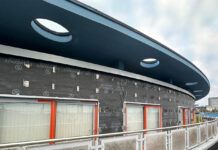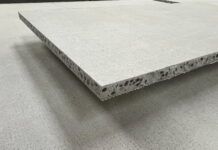An Architectural Profiles Limited (APL) ‘Full System Warranty’ is a partnership between APL and the cladding installer in which the manufacturer takes full responsibility for the materials, the detailing and the assembly, and the installer takes responsibility for the labour and quality of installation. The difference between one warranty and another is said to hang on how the project is controlled and ‘policed’ to give a fully traceable, written, record on all aspects of both materials and installation.
As a designer and manufacturer of metal cladding and rainscreen panels and systems, APL has specialised in the complete design and supply of non-combustible/fire retardant assemblies for over 30 years and ‘Cladshield’ is its ‘full system’ warranty.
So, what makes ‘Cladshield’ different? The company says it is the fact that all installations are regularly inspected, with written reports and photographic records of the actual installation, by an independent, PI-backed, registered MCRMA inspector. The number of visits to site will be structured to suit the size and complexity of the project. The on-site ‘Cladshield’ process starts with the initial ‘tool box’ talk to the actual fitters on site and carries right through to the final completion and hand over.
All aspects of the installation are assessed, documented and agreed by all parties in a pre-start quality plan which is then said to be followed by a detailed, hard copy, rigorous, on-site inspection and quality plan which has to be completed and ‘signed off’ at every stage. In this way there is said to be ‘100% traceability, 100% responsibility and 100% accountability’.
There can reportedly be no opportunity left at any point to cut corners to downgrade spec on any component part, so there can be no doubt, when the building owner receives his ‘Cladshield’ 25-year warranty that it really is a document of real substance and real value.
“But this is nothing new you may say, such quality controls have been talked about a lot, but in the past all too often such controls have been either overlooked or not costed in to the project at the outset, again often at the risk of expensive retrospective site inspections and remedial works, or the issuance of a worthless piece of paper,” said the company. “Today the cost of the preparation of the QA plans and the cost of the inspectors’ site visits reportedly represent a tiny fraction of the cost of the project, subject to size and complexity usually less than 0.025%, yet can regularly demonstrate real benefits for the building owner, not only for the peace of mind it brings, but also in terms of substantial reductions in annual buildings insurance premiums for the owner occupier, and for the designer/architect similar savings in PI insurance.”
APL says it works with many of the country’s ‘leading’ architectural practices and specifiers representing many high profile, high visibility clients. Regular comments from project leading architects reportedly talk of the value in being able to offer complete confidence and a worry-free exercise for their clients which, when set against current industry concerns, has a real value in itself. APL says that the real key to ‘Cladshield’ is the traceability it brings to a project and the knowledge that a real person has put their name to every detail of both materials and installation.
The company predicts that one day it will become a legal requirement for all projects to be quality checked in this way, but until then it is the responsibility of the project lead to demand it.




